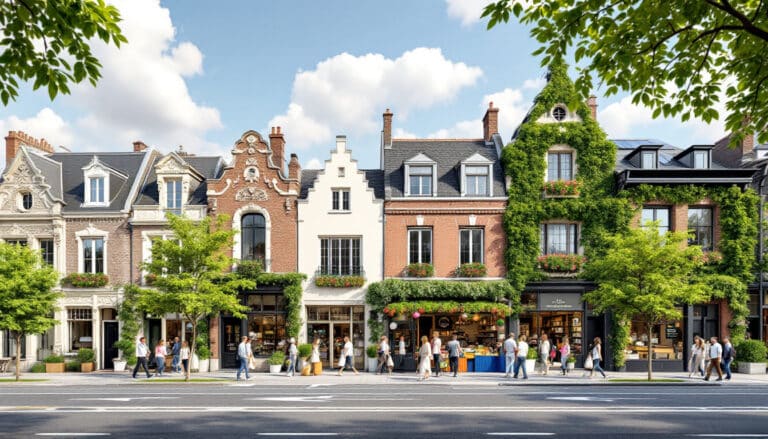In 2024, the real estate market underwent significant transformations. The decrease in interest rates has renewed confidence among potential buyers. The profiles of purchasers have evolved noticeably.
The average age of new home buyers is now 41.5 years, reflecting a greater maturity in purchasing decisions. The majority of buyers are in couples, representing 75.5% of transactions, with an increasing share of first-time buyers reaching 54.7%. A quarter of buyers are under 30 years old, indicating an interesting dynamic among younger individuals. Transactions are primarily focused on the purchase of single-family homes, with an increasing average budget. This evolution demonstrates the market’s adaptation to the new aspirations and financial capabilities of households.
Table of Contents
ToggleIntroduction to the profile of new home buyers
The market for new real estate is constantly evolving, influenced by various economic and social factors. In 2024, several trends have emerged, redefining the landscape of new home buyers in France. Understanding their age, marital status, and region of origin is essential for professionals in the sector, whether they are builders, real estate agents, or investors.
What is the average age of new home buyers in 2024?
The average age of new home buyers in 2024 is 41.5 years, according to a study by the Hexaom group. This age range reflects a generally stable population financially, ready to commit to a substantial real estate investment. However, it is interesting to note that a quarter of these buyers are under 30 years old, demonstrating a certain demographic diversification. This trend can be explained by the decrease in interest rates, making real estate purchases more accessible to younger individuals.
Compared to previous years, the median age has slightly increased, from 39 years in 2022 to 42 years in 2024. This rise is primarily due to the difficulties in accessing credit for young people and the continued increase in property prices in many regions.
What is the marital status of new home buyers?
The marital status plays a crucial role in the profile of new home buyers. In 2024, 81% of buyers are in couples, while 19% are single. This predominance of couples can be explained by the need for stability and security that comes with acquiring real estate. Additionally, couples generally have a higher purchasing power and are more inclined to invest in long-term projects.
Moreover, among couples, a significant majority are first-time buyers, representing 54.7% of purchasers. This reflects a renewed willingness to settle in a new home, benefiting from tax advantages and guarantees offered by builders.
What are the regional profiles of new home buyers?
The region of origin of new home buyers shows notable disparities. Urban areas, particularly large metropolises like Paris, Lyon, and Toulouse, are seeing increased demand for new housing. This trend is fueled by a young and active population seeking to live near economic activity centers.
Conversely, rural or less densely populated areas are also experiencing a rise in demand due to the search for a quieter living environment and a generally lower cost of living. Additionally, the pandemic has encouraged teleworking, allowing many individuals to choose less central locations while remaining professionally connected.
The regions in the south of France, in particular, attract numerous buyers due to a pleasant climate and a high quality of life. Investments in infrastructure and urban development projects also contribute to energizing the new real estate market in these areas.
What are the financial behaviors of new home buyers?
In 2024, the drop in interest rates has restored purchasing power to households, facilitating access to mortgage credit. Buyers now have a greater borrowing capacity, allowing them to consider more ambitious purchasing projects. On average, buyers contribute a significant personal contribution, strengthening their position during financing negotiations.
Moreover, the duration of mortgage loans tends to lengthen, allowing buyers to spread their repayments over longer periods and reduce the monthly financial pressure. This evolution promotes better budget management and encourages more households to embark on the purchase of a new home.
It is also notable that first-time buyers, although representing a significant share of purchasers, show a slight decrease compared to 2023. This can be attributed to increased competition in the market and rising property prices in certain regions, making home ownership more complex for newcomers.
What types of properties are preferred by new home buyers?
In 2024, new home buyers show a marked preference for single-family homes, representing 68% of real estate transactions. This inclination is explained by the desire to obtain personalized space, often accompanied by a garden or terrace, offering better quality of life and greater privacy.
New apartments also constitute a significant portion of the market, accounting for 31% of purchases. These properties are particularly sought after by single individuals and young couples, often attracted by the proximity of urban amenities and public transport. Studios and small apartments offer a practical and functional solution for those seeking housing without the constraints of a large house.
Additionally, there is a growing trend for environmentally friendly properties. New homes equipped with eco-friendly technologies and benefiting from energy certifications are increasingly attracting buyers concerned about their environmental impact. This orientation towards sustainability is a response to current concerns related to climate change and energy transition.
How does the purchasing power of property buyers evolve?
The decrease in interest rates in 2024 has significantly improved the purchasing power of households, making real estate purchases more accessible. This decrease has lowered loan monthly payments and increased the amount of possible loans, thus providing buyers with the opportunity to acquire higher quality or larger properties.
As a result, households can now consider more ambitious purchasing projects, particularly by opting for developing neighborhoods or homes with high-end features. This dynamic promotes an increase in real estate transactions and stimulates the growth of the new home construction market.
Moreover, the strengthening of borrowing capacity allows buyers to make a more substantial personal contribution, thereby improving their financial profile and attractiveness to banks. This situation generates increased confidence in the real estate market, encouraging more households to invest in new property.
What are the main attractive regions for the purchase of new homes?
Several regions stand out in 2024 for their attractiveness for purchasing new homes. Île-de-France remains a key area, despite high property prices, due to strong demand and the professional opportunities it offers. Buyers are attracted by the proximity of transportation infrastructure and the cultural richness of the region.
The South of France also sees strong demand, thanks to its pleasant climate and quality of life. Cities like Nice, Montpellier, or Toulouse are witnessing an increase in construction projects, attracting a diverse population, from young professionals to families seeking stability.
Regions like Auvergne-Rhône-Alpes and Nouvelle-Aquitaine also benefit from notable dynamism. The quality of infrastructure, economic opportunities, and diverse landscapes attract a wide range of buyers, from first-time buyers to investors.
Finally, less populated and rural regions are gaining popularity, especially among teleworkers and families seeking a more serene living environment. These areas often offer more spacious land and more affordable property prices, providing an attractive alternative to large metropolises.
What are the main motivations of new home buyers?
The motivations of new home buyers are diverse and reflect current social and economic developments. Security and stability are key factors, particularly for couples wishing to settle down permanently. Home ownership is seen as a safe investment and a guarantee of family heritage.
The customization of living space is also a major motivation. Buyers favor new homes to adapt spaces to their specific needs, choose finishes, and integrate modern technologies such as home automation.
Finally, eco-responsibility plays an increasingly important role in purchasing decisions. Buyers seek energy-efficient housing equipped with eco-friendly heating systems and constructed with sustainable materials. This environmental concern influences the choices of construction and location of new real estate projects.
Impact of economic trends on the buyer profile
The economic trends of 2024 have a significant impact on the profile of new home buyers. The post-pandemic economic recovery and the stability of interest rates have created a favorable environment for real estate investment. Households, benefiting from better financial health and renewed confidence, are more inclined to invest in new properties.
Moreover, controlled inflation and housing support policies encourage first-time buyers and families to take the step toward home ownership. Incentive measures, such as purchase assistance and tax reductions for new constructions, reinforce this dynamic.
Furthermore, the digitalization of the real estate sector facilitates the search for and purchase of new properties. Online tools, virtual tours, and simplified administrative processes make the acquisition process more accessible and transparent, attracting a larger and more diverse clientele.
The challenges faced by new home buyers
Despite the opportunities, new home buyers face several challenges in 2024. One of the main obstacles remains the rise in property prices in certain regions, making home ownership more difficult for budget-constrained households. This increase in costs is accompanied by heightened competition in the market, forcing buyers to be more selective and strategic in their choices.
The complexity of administrative procedures also represents a notable challenge. Although efforts have been made to simplify the acquisition process, many buyers still find the purchasing journey long and tedious. Support from competent professionals remains essential for successfully navigating this context.
Finally, the issues related to sustainability and energy performance require special attention. Buyers are increasingly aware of their environmental impact and seek properties that comply with the strictest ecological standards. This can sometimes limit the available options and impose more stringent selection criteria.
Future perspectives on the profile of new home buyers
The prospects for the profile of new home buyers in 2025 and beyond show promising and evolving trends. Technological innovation will continue to influence buyers’ expectations, with increased demand for smart and connected housing. New generations, more tech-savvy, will seek homes that incorporate advanced home automation solutions and optimized energy management systems.
Furthermore, urbanization and the demand for flexible lifestyles will lead to diversification in property types. Modular homes, allowing adaptations based on the changing needs of occupants, will gain popularity. This flexibility will meet the demands of a changing society where telecommuting and professional mobility become the norm.
Moreover, the growing awareness of ecology and sustainable development will inspire new construction standards. Buyers will increasingly seek environmental certifications and favor eco-friendly materials, thus reinforcing the trend toward greener and more responsible constructions.
Finally, financial accessibility will remain a key issue. Public policies will need to continue supporting access to home ownership for first-time buyers and low-income households, maintaining attractive credit conditions and encouraging the construction of affordable housing.
The profile of new home buyers in 2024 reflects an evolution toward a more diverse population that is aware of its needs and expectations. The age, marital status, and region of origin play a determining role in purchasing decisions, just as do economic and environmental factors. Understanding these dynamics enables real estate actors to better target their offers and respond effectively to buyers’ aspirations, thus contributing to a dynamic and resilient real estate market.















